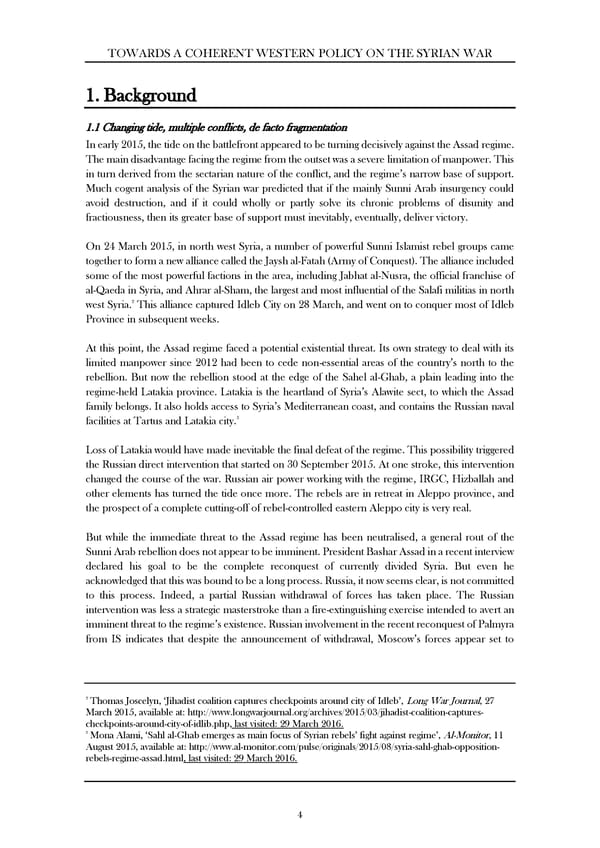TOWARDS A COHERENT WESTERN POLICY ON THE SYRIAN WAR 1. Background 1.1 Changing tide, multiple conflicts, de facto fragmentation In early 2015, the tide on the battlefront appeared to be turning decisively against the Assad regime. The main disadvantage facing the regime from the outset was a severe limitation of manpower. This in turn derived from the sectarian nature of the conflict, and the regime’s narrow base of support. Much cogent analysis of the Syrian war predicted that if the mainly Sunni Arab insurgency could avoid destruction, and if it could wholly or partly solve its chronic problems of disunity and fractiousness, then its greater base of support must inevitably, eventually, deliver victory. On 24 March 2015, in north west Syria, a number of powerful Sunni Islamist rebel groups came together to form a new alliance called the Jaysh al-Fatah (Army of Conquest). The alliance included some of the most powerful factions in the area, including Jabhat al-Nusra, the official franchise of al-Qaeda in Syria, and Ahrar al-Sham, the largest and most influential of the Salafi militias in north 2 west Syria. This alliance captured Idleb City on 28 March, and went on to conquer most of Idleb Province in subsequent weeks. At this point, the Assad regime faced a potential existential threat. Its own strategy to deal with its limited manpower since 2012 had been to cede non-essential areas of the country’s north to the rebellion. But now the rebellion stood at the edge of the Sahel al-Ghab, a plain leading into the regime-held Latakia province. Latakia is the heartland of Syria’s Alawite sect, to which the Assad family belongs. It also holds access to Syria’s Mediterranean coast, and contains the Russian naval facilities at Tartus and Latakia city.3 Loss of Latakia would have made inevitable the final defeat of the regime. This possibility triggered the Russian direct intervention that started on 30 September 2015. At one stroke, this intervention changed the course of the war. Russian air power working with the regime, IRGC, Hizballah and other elements has turned the tide once more. The rebels are in retreat in Aleppo province, and the prospect of a complete cutting-off of rebel-controlled eastern Aleppo city is very real. But while the immediate threat to the Assad regime has been neutralised, a general rout of the Sunni Arab rebellion does not appear to be imminent. President Bashar Assad in a recent interview declared his goal to be the complete reconquest of currently divided Syria. But even he acknowledged that this was bound to be a long process. Russia, it now seems clear, is not committed to this process. Indeed, a partial Russian withdrawal of forces has taken place. The Russian intervention was less a strategic masterstroke than a fire-extinguishing exercise intended to avert an imminent threat to the regime’s existence. Russian involvement in the recent reconquest of Palmyra from IS indicates that despite the announcement of withdrawal, Moscow’s forces appear set to 2 Thomas Joscelyn, ‘Jihadist coalition captures checkpoints around city of Idleb’, Long War Journal, 27 March 2015, available at: http://www.longwarjournal.org/archives/2015/03/jihadist-coalition-captures- checkpoints-around-city-of-idlib.php, last visited: 29 March 2016. 3 Mona Alami, ‘Sahl al-Ghab emerges as main focus of Syrian rebels’ fight against regime’, Al-Monitor, 11 August 2015, available at: http://www.al-monitor.com/pulse/originals/2015/08/syria-sahl-ghab-opposition- rebels-regime-assad.html, last visited: 29 March 2016. 4
 Towards A Coherent Policy On The Syrian War Page 5 Page 7
Towards A Coherent Policy On The Syrian War Page 5 Page 7